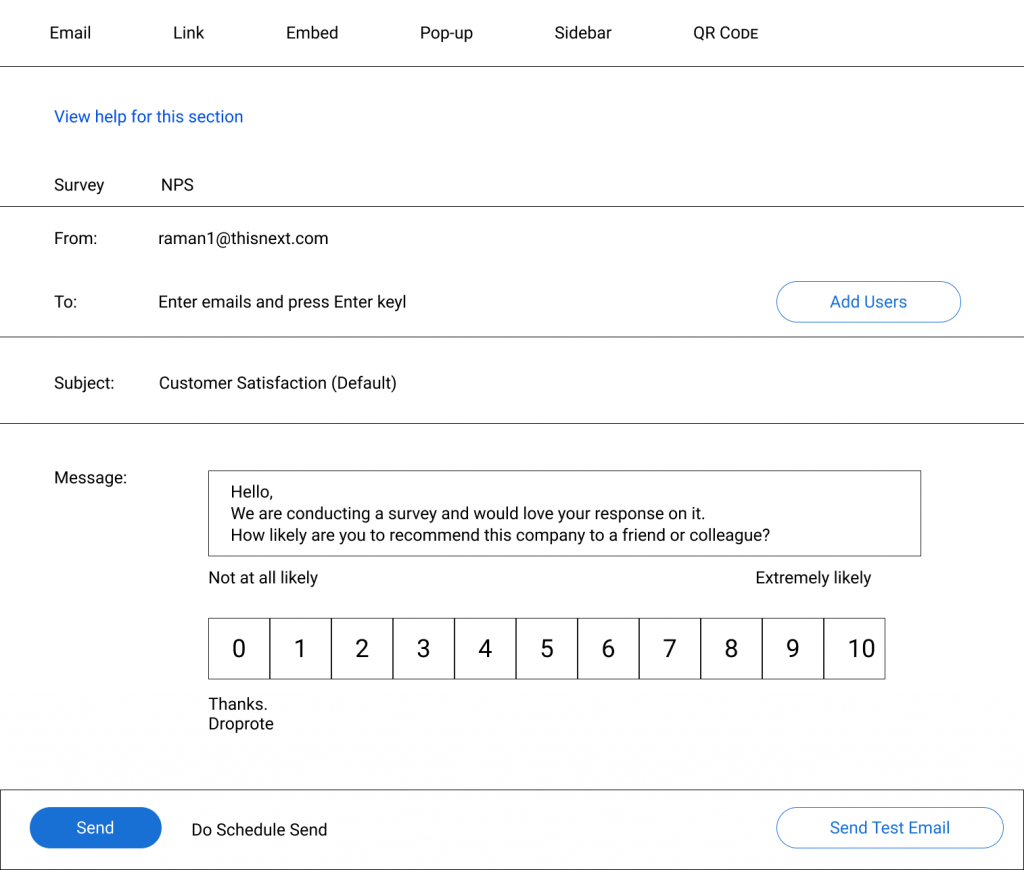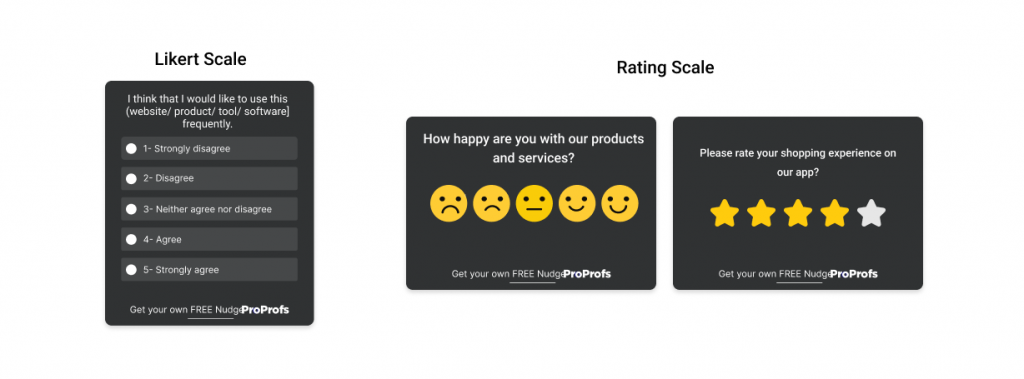Ever wondered why some surveys feel like a chore while others are a breeze?
Imagine a survey that’s so engaging it feels like a conversation with an old friend. That’s the magic of a well-crafted survey. In today’s data-driven world, surveys are the secret to unlocking invaluable insights.
Whether you’re seeking customer feedback or diving into market research, creating a compelling survey is crucial. Welcome to our ultimate guide on designing surveys that capture attention and yield actionable results.
Get ready to transform your surveys from mundane to magnificent and start collecting data that drives real change. Let’s dive in!
12 Tips for Creating Effective Surveys
The tips below are based on the best practices followed by industry-giants and thought leaders and experts. These tips are not magic but simple practices foundational to effective surveys. Let’s take a look:
1. Define Your Survey Goals
Imagine setting out on a journey without a destination in mind. You’d likely end up lost and frustrated. Similarly, crafting a survey without clear goals can lead to ambiguous results and wasted efforts.
Clear goals ensure your survey is focused, relevant, and capable of delivering actionable insights. They guide the structure of your questions, the type of data you collect, and ultimately, how you interpret the results.
Examples of common survey goals:
- Customer Satisfaction: Understanding how happy customers are with your products or services.
- Product Feedback: Gathering insights on how a product is performing and identifying areas for improvement.
- Market Research: Exploring market trends, customer preferences, and potential opportunities.
Here’s how you can set specific, measurable, and achievable goals:
- Instead of a vague goal like “improve the product,” aim for “identify key features customers love and areas needing improvement in our new product.”
- Ensure your goals can be quantified. For instance, “increase customer satisfaction score by 10%.”
- Set realistic goals based on your resources and timeframe. If you’re a small startup, a goal like “survey 1,000 customers in a month” might be more realistic than aiming for 10,000.
2. Know Your Audience
When you understand who your respondents are, you can tailor your questions to resonate with them, making your survey more engaging and relevant. This increases the likelihood of obtaining honest and useful responses.
You can identify and segment your audience using:
- Demographic Analysis: Break down your audience by age, gender, income, education level, etc. This helps in understanding broad characteristics.
- Behavioral Analysis: Look at how your audience interacts with your products or services. Are they frequent buyers? Do they only purchase during sales?
- Psychographic Analysis: Dive into their interests, values, and lifestyles. What motivates their purchasing decisions? What are their pain points?
Once you’ve segmented your audience, it’s crucial to frame your questions in a way that aligns with their language and comprehension level. For instance:
- For a young, tech-savvy audience: Use casual language and assume familiarity with digital trends. Example: “How often do you use our app to make purchases?”
- For a professional, older audience: Maintain a formal tone and provide clear instructions. Example: “Please rate your satisfaction with our customer service on a scale of 1 to 10.”
For example, if your survey goal is to understand how satisfied young professionals are with your new mobile app, your questions should reflect their tech-savviness and busy lifestyles.
Instead of asking, “Do you find our mobile app useful?” which is too broad, you could ask, “On a scale of 1 to 10, how likely are you to recommend our product to a colleague for its ease of use?”

Create Your Own Survey Within Minutes
By defining clear goals and understanding your audience, you set a strong foundation for creating surveys that not only engage respondents but also provide valuable, actionable insights.
Here another interesting read: Customer Segmentation Analysis: Types, Examples, & Methods
3. Choose the Right Survey Type
Selecting the appropriate survey type is essential to achieving your survey goals and engaging your audience effectively. Here are some common types:
- Online Surveys
What Are On-Site Surveys? Examples & Benefits
In the digital age, online surveys have become the go-to method for gathering customer feedback, offering unparalleled convenience and reach. Tools like Qualaroo make it easy to embed surveys on your website, within your software product, or even in a prototype.
This approach allows you to reach a wider audience and gather nuanced, inclusive insights by targeting diverse respondents. You can automate your research with timely surveys and set advanced triggers to target specific customer segments based on browsing behavior, purchase history, and more.
Qualaroo’s pop-up NudgesTM helps you collect contextual insights and measure various customer satisfaction metrics effectively. For example, an eCommerce company might use an online survey on its website to understand consumer preferences for a new product line.
- Mobile App Surveys
With smartphones everywhere, mobile surveys are perfect for quick, on-the-go feedback. Easily accessible on mobile devices, they offer a seamless experience for participants.
Use in-app surveys or tools like Qualaroo to create mobile web surveys. Retailers, for example, can send a quick SMS survey link after a purchase to capture instant feedback.
Mobile surveys are great for real-time insights and engaging younger audiences. Just ensure they are mobile-friendly with short, straightforward questions to fit smaller screens and cater to users on the move.
How to Collect Mobile App Feedback
| Read in detail: Mobile App Survey: A Complete Guide |
- Face-to-Face Interviews:
Telephone surveys, though less popular today due to caller ID and privacy concerns, still offer valuable personal interaction in certain contexts.
Political polling organizations, for example, use them to gather detailed opinions on candidates and issues, benefiting from the ability to probe deeper into responses. While this method can yield richer data, it also faces challenges like increasing refusal rates and the costs of staffing call centers.
- Phone Surveys:
Phone surveys allow for personal interaction and immediate clarification of questions, which are suitable for reaching less tech-savvy audiences. Pros: Personal touch, immediate clarification possible. Cons: Can be seen as intrusive, declining response rates.
- Mail Surveys:
Email surveys are widely used, sending surveys and invitations directly to participants’ inboxes. This method is highly cost-effective and allows for easy distribution to a large audience quickly.
With tools like ProProfs Survey Maker, part of Qualaroo, you can embed surveys into your emails, enabling participants to take the survey as soon as they open their email.
Bonus read: In-App Vs. Email Vs. SMS Surveys: What’s Best for Your Business
Tips on selecting the right type based on your goals and audience
- Consider your audience’s accessibility and preferences. For instance, if your target audience is tech-savvy, an online survey is ideal.
- Think about the depth of data needed. For in-depth qualitative insights, face-to-face interviews might be best.
- Evaluate your resources and budget. Online surveys are cost-effective, while face-to-face interviews require more resources.
For example, if you’re surveying millennials about a new mobile app feature, an online survey would be fitting due to their digital engagement. Conversely, for senior citizens’ feedback on healthcare services, a phone survey might be more effective.
4. Craft Clear and Concise Questions
The clarity and simplicity of your questions are paramount to obtaining accurate and useful responses. Ambiguous or complex questions can confuse respondents, leading to unreliable data.
Clear and concise questions ensure that respondents understand exactly what is being asked, which increases the quality and reliability of their answers.
Follow these points to ensure you ask the right questions:
- Use Simple Language: Avoid jargon and technical terms that might confuse respondents. Stick to everyday language that your audience understands.
- Be Specific: Vague questions can lead to vague answers. Make your questions as specific as possible to get precise data.
- Avoid Double-Barreled Questions: Don’t combine two questions into one. For example, instead of asking, “How satisfied are you with our product’s quality and price?” separate it into two questions.
Examples of well-written vs. poorly-written questions
Poorly Written Question: “Do you use our product regularly?”
This is vague and open to interpretation. What does “regularly” mean?
Well-Written Question: “How many times per week do you use our product?”

Create Your Own Survey Within Minutes
This is specific and quantifiable, leading to more precise data.
Instead of asking questions like these, ask them like this:
- Multiple-Choice Questions: Offer a range of predefined answers.
- Example: “Which of the following features do you use the most? (A) Speed (B) Design (C) Price (D) Customer Support.”
- Best Practice: Ensure options are mutually exclusive and collectively exhaustive.
- Likert Scale Questions: Measure the degree of agreement or satisfaction.
- Example: “On a scale of 1 to 5, how satisfied are you with our customer service?”
- Best Practice: Provide a balanced scale (e.g., 1 = Very Dissatisfied, 5 = Very Satisfied).
- Open-Ended Questions: Allow respondents to provide detailed, qualitative answers.
- Example: “What do you like most about our product?”
- Best Practice: Use sparingly and follow up with specific prompts to guide responses.
Here’s your next read: 26 Common Types of Survey Errors and How to Correct Them
5. Use a Variety of Question Types
Variety is the spice of life, and the same goes for surveys.
Using a mix of question types keeps respondents engaged and allows you to gather different kinds of data. This variety helps in capturing a holistic view of your respondents’ opinions and experiences.

Multiple-choice questions offer predefined answers, making it simple for respondents to choose. Likert scale questions are perfect for measuring attitudes or opinions across a spectrum.
Open-ended questions, on the other hand, give respondents the freedom to express their thoughts in their own words, providing deeper insights and Rating scale questions ask respondents to rate something on a numerical scale, giving you quantifiable data.
Dropdown questions, ideal for queries with many possible answers, help save space and keep your survey clean and organized. This variety ensures a comprehensive and engaging survey experience.
Benefits of using a mix of question types to gather comprehensive data are:
- Multiple-Choice Questions: Quick and easy for respondents, providing clear, structured data. Example: “Which feature do you use most often? (A) Chat (B) Video Call (C) File Sharing”
- Likert Scale Questions: Ideal for gauging sentiments and attitudes. Example: “On a scale of 1 to 5, how satisfied are you with our customer service?”

- Rating Scale Questions: Quantify satisfaction or likelihood. Example: “Rate your overall satisfaction with our service on a scale of 1 to 10.”
- Open-Ended Questions: Gather detailed insights and uncover nuances. Example: “What improvements would you suggest for our product?”
- Dropdown Questions: Streamline questions with many options. Example: “Select your country of residence.”
When designing your survey, following best practices for each question type ensures clarity and effectiveness. For multiple-choice questions, make sure the options are mutually exclusive and cover all possible answers to avoid confusion.
With Likert scale questions, provide a balanced scale with clear labels for each point to accurately measure attitudes or opinions. Use open-ended questions sparingly to avoid survey fatigue and follow up with specific prompts to gather detailed insights.
Maintain a consistent scale throughout your survey for rating scale questions, making comparisons easier. For dropdown questions, list options alphabetically or logically to facilitate navigation and ensure a smooth respondent experience.
Also read: Survey Abandonment Guide: Causes, Impact & Solutions
6. Keep the Survey Short and Focused
Lengthy surveys can deter respondents, leading to lower completion rates and potentially skewed data. Keeping your survey short and focused ensures higher engagement and better quality responses.
Tips for keeping the survey concise while gathering necessary information
- Prioritize Questions: Focus on essential questions that directly align with your survey goals.
- Group Similar Questions: This helps in maintaining a logical flow and avoids redundancy.
- Use Skip Logic: Only show relevant questions based on previous answers, reducing the number of questions each respondent sees.
Strategies for prioritizing questions and eliminating unnecessary ones
- Review and Edit: Regularly review your questions to ensure each one serves a purpose.
- Combine Questions: Where possible, combine two questions into one without losing clarity.
- Pilot Testing: Test your survey to identify and remove redundant or unclear questions.
For example, instead of asking, “How satisfied are you with our product quality?” and “How satisfied are you with our product design?”, you could combine them into, “How satisfied are you with our product’s quality and design?”
7. Test Your Survey
Testing your survey before full deployment helps identify and fix issues that could lead to inaccurate data or respondent drop-off. It ensures that your survey is clear, concise, and effective. With Qualaroo, you can enjoy a full, interactive preview of your survey before publishing it anywhere.

Methods for testing your survey
- Pilot Testing: Share the survey with a small group representative of your target audience to gather feedback on clarity and flow.
- A/B Testing: Create two versions of the survey with slight variations to determine which performs better.
- Expert Review: Have colleagues or experts review the survey to catch any issues you might have missed.
Gathering feedback from testers and making necessary adjustments
- Ask for Detailed Feedback: Encourage testers to point out confusing questions, technical issues, and areas for improvement.
- Analyze Responses: Look at completion rates, time taken, and responses to identify problematic areas.
- Iterate and Improve: Make necessary adjustments based on feedback and test again, if needed.
8. Ensure Mobile Compatibility
With the majority of people accessing the internet via smartphones, ensuring your survey is mobile-friendly is crucial. A mobile-compatible survey enhances user experience, leading to higher response rates.
You need to ensure your survey platform supports responsive design so it adapts seamlessly to various screen sizes.
Keep it simple by avoiding large blocks of text and complex layouts that are hard to navigate on small screens. Use touch-friendly elements, making buttons and answer options large enough to tap easily.
Also, when crafting questions, opt for concise, straightforward ones. For example, instead of asking, “Please describe your overall experience with our service in detail,” ask, “Rate your overall experience with our service on a scale of 1 to 10.”
Also read: 7 Steps to Conduct a Survey- Best Practices, Tools, & More
9. Use Skip Logic and Branching
Skip logic or branching logic allows you to create a more personalized and relevant survey experience by directing respondents to different questions based on their previous answers.
This not only makes the survey more engaging but also ensures that respondents only see questions that are relevant to them.
Benefits of creating a more personalized survey experience
- Increased Engagement: Respondents are more likely to complete the survey when they feel it’s tailored to their experiences.
- Reduced Survey Fatigue: By skipping irrelevant questions, you shorten the survey length, making it less tedious for respondents.
- Improved Data Quality: Collect more accurate and relevant data by directing respondents to appropriate follow-up questions.
Examples of how to implement skip logic and branching effectively
- Example 1: If a respondent answers “No” to “Have you used our product before?”, skip questions about product usage and direct them to questions about their awareness of the product.
- Example 2: If a respondent rates customer service as poor, branch them to follow-up questions asking for more details about their experience.
10. Optimize Survey Timing and Frequency
The timing of when you send out your survey can significantly impact response rates. Sending surveys at the right time ensures higher engagement and better-quality responses. Here are some of the ways in which Qualaroo allows you to time your surveys and set their frequency:
Timing is everything when it comes to sending surveys. Think about your audience’s schedule; for working professionals, try sending your survey during lunch breaks or after work hours.
Avoid peak busy times like holidays or end-of-quarter crunches. To avoid survey fatigue, aim for quarterly or biannual surveys. If you need to survey more often, mix up the topics to keep things interesting.
For instance, if you’re in retail, sending a customer satisfaction survey a week after a purchase captures fresh experiences and boosts response rates. By considering timing and variety, you’ll get meaningful feedback without overwhelming your audience.
11. Ensure Confidentiality and Anonymity
Respondents are likelier to give candid feedback if they know their responses are confidential and anonymous. Ensuring this builds trust and boosts participation.
To communicate privacy policies clearly, be transparent: clearly state how the data will be used, stored, and protected. Use survey tools that support anonymous responses and let your respondents know their anonymity is guaranteed.
For handling and storing survey data securely, use data encryption to protect sensitive information, limit access to authorized personnel only, and conduct regular audits to ensure compliance with data protection policies.
For example, include a privacy statement at the beginning of your survey, such as: “Your responses will be kept confidential and anonymous. We value your privacy and will not share your information with third parties.” This approach fosters trust and encourages more genuine feedback.
Also read: 10 Best Anonymous Feedback Tools to Collect Unbiased Insights
12. Allow for Open-Ended Responses
Open-ended questions allow respondents to express their thoughts and provide insights that you might not have considered. They can reveal underlying issues and highlight areas for improvement.
Tips for framing open-ended questions to encourage thorough responses
- Be Specific: Ask clear, focused questions to guide the respondent.
- Provide Context: Offer a brief explanation if necessary to clarify what you’re seeking.
Examples of effective open-ended questions
- Example 1: “What do you like most about our product?”
- Example 2: “How can we improve your experience with our service?”
For example, instead of asking, “Do you have any comments?”, you could ask, “What additional features would you like to see in our product?”
Unlock the Power of Effective Surveys
Surveys are a powerful tool for gathering valuable insights and understanding your audience. By implementing tips like skip logic and branching, optimizing survey timing and frequency, ensuring confidentiality and anonymity, etc., you can create surveys that are not only more engaging for respondents but also yield richer, more actionable data.
Whether you choose online, telephone, or email surveys, each method offers unique benefits. Start leveraging these tips today to enhance your feedback collection and drive better decision-making.
FREE. All Features. FOREVER!
Try our Forever FREE account with all premium features!

 We'd love your feedback!
We'd love your feedback! Thanks for your feedback!
Thanks for your feedback!







